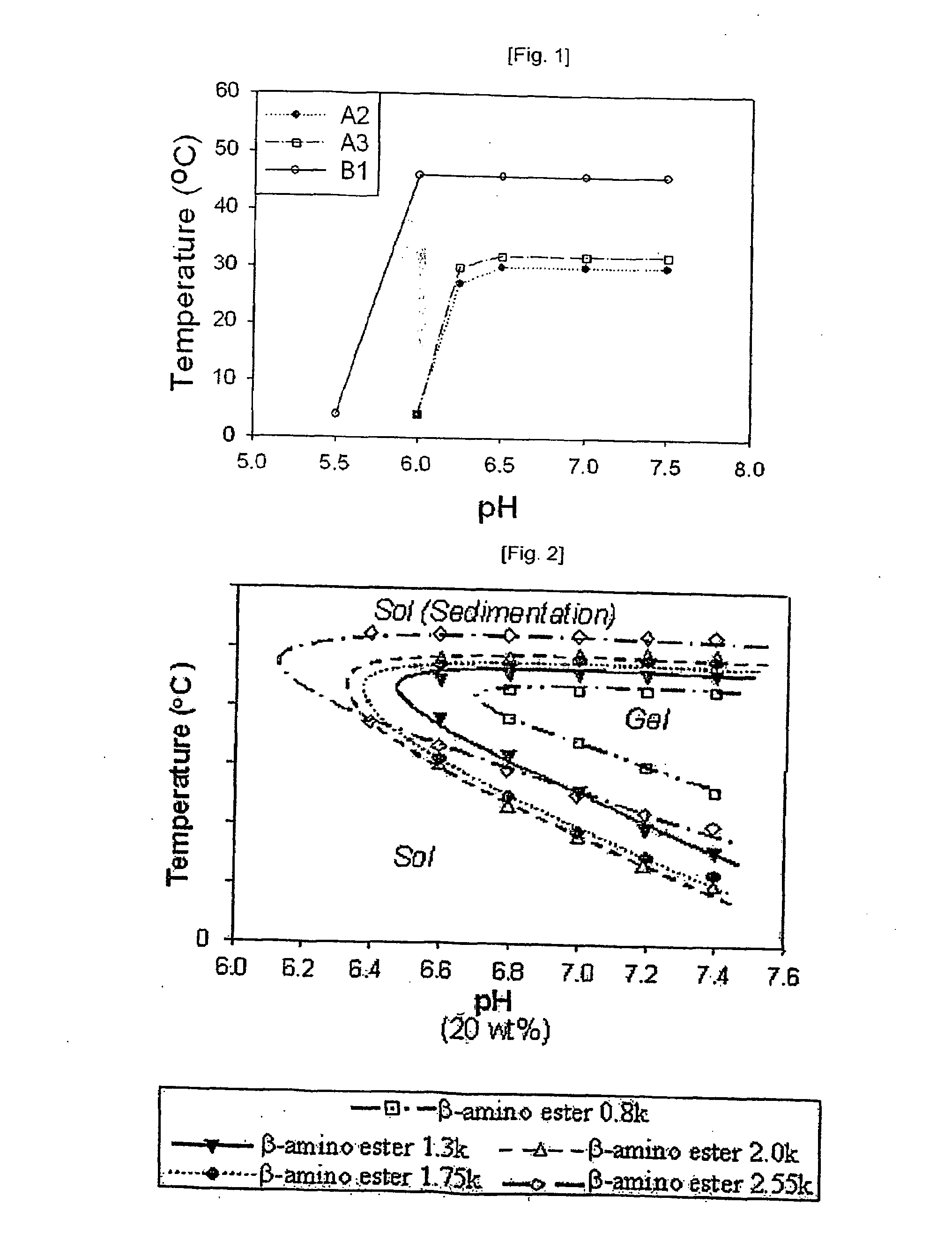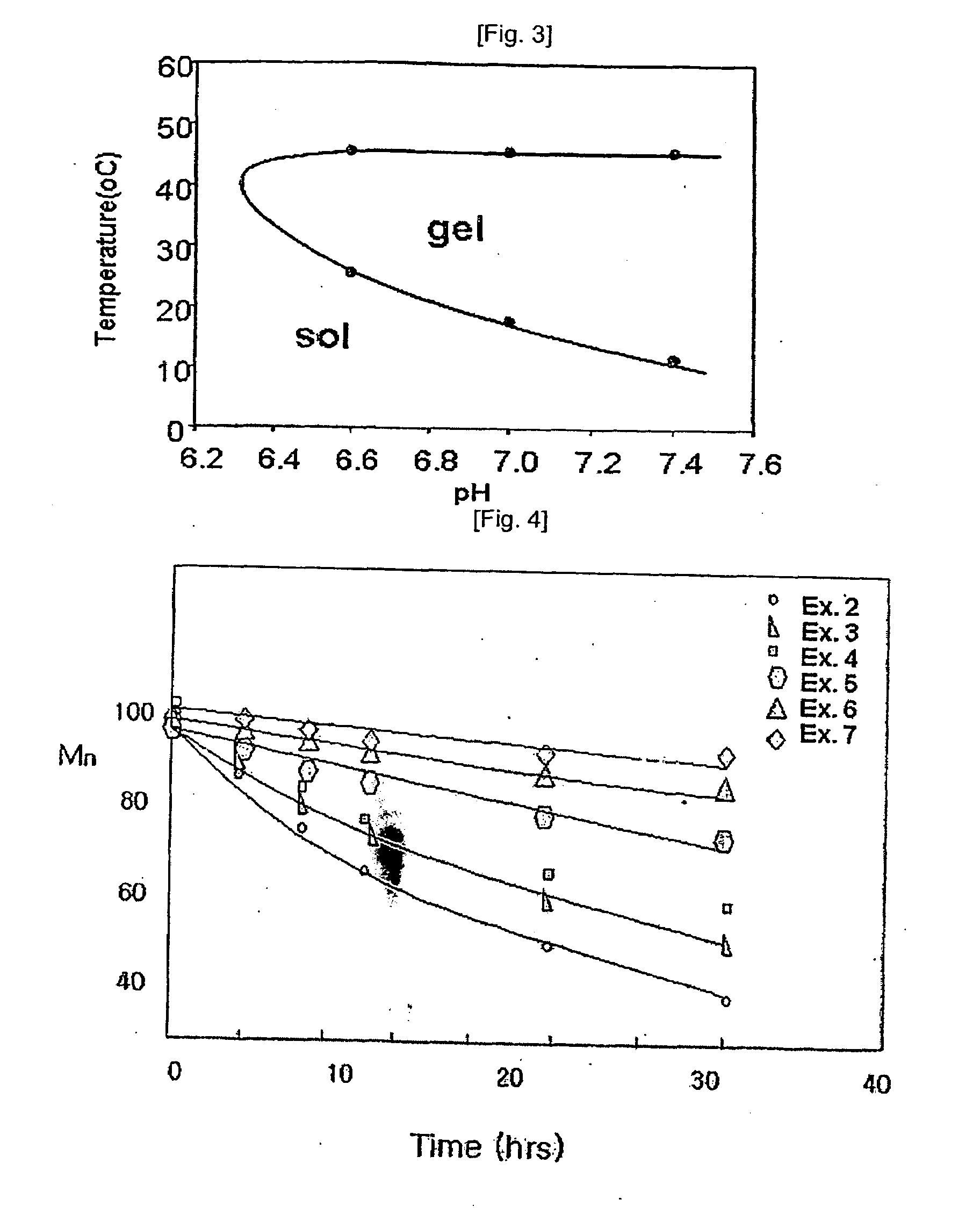Temperature and Ph Sensitive Block Copolymer and Polymeric Hydrogels Using the Same
a technology of temperature and ph sensitivity and block copolymer, which is applied in the direction of medical preparations, non-active ingredients of pharmaceuticals, etc., can solve the problems that the block copolymer according to the prior art is not suitable to be applied to the drug delivery system, and achieve the effect of improving temperature sensitivity and ph sensitivity
- Summary
- Abstract
- Description
- Claims
- Application Information
AI Technical Summary
Benefits of technology
Problems solved by technology
Method used
Image
Examples
example 1
Preparation of Polyethylene Glycol-Biodegradable Polyester Polymer (Polycaprolactone)-Poly(β-amino ester) Triblock Copolymer (PAE)
[0071]First, 10 g of polyethylene glycol methyl ether (MPEG, Mn=2000, 5000) and 0.2 g of stannous octoate (catalyst) were introduced into a reactor and the reaction mixture was dried under vacuum at 110° C. for 4 hours to remove water. After cooling the dried reaction mixture, 6.0 g (5.576 ml) of ε-caprolactone as a biodegradable polyester polymer were added thereto under nitrogen atmosphere, and then the resultant reaction mixture was heated gradually to 135° C. under nitrogen atmosphere and subjected to polymerization for 24 hours. It was possible to obtain an MPEG-PCL block copolymer having a desired molecular weight by controlling the amount of MPEG and the addition amount of ε-caprolactone so as to control the molecular weight. Stannous octoate was used in an amount of 0.5 wt % based on the amount of MPEG. After the completion of the reaction, the re...
example 2
Temperature- and pH-Sensitive Pentablock Copolymer
[0074]Example 1 was repeated to obtain triblock copolymers (PCLA-PEG-PCLA) comprising ε-caprolactone, D,L-lactide and polyethylene glycol and having various molecular weights, except that polyethylene glycol (PEG, Mn=1500, 1750, 2000) was used instead of polyethylene glycol ether and DL-lactide was further added besides ε-caprolactone. Each product was obtained with a yield of 91% or more.
[0075]The PCLA-PEG-PCLA block copolymer obtained as described above was introduced into a reactor and was dried at 85° C. under vacuum to remove water. After cooling the reaction mixture to room temperature, methylene chloride was added thereto under nitrogen atmosphere to dissolve the block copolymer. Then, triethyl amine was added to the reaction mixture in a molar ratio of 3:1 based on the amount of the block copolymer in order to remove HCl as a byproduct, and the dissolved product was cooled to 10° C. Then, acryloyl chloride was added dropwise ...
example 3
[0078]Example 2 was repeated to provide a pentablock copolymer of poly(β-amino ester-amido amine)-PCLA-PEG-PCLA-poly(β-amino ester-amido amine) having a molecular weight of 6800, except that 1,6-hexanediol diacrylate and N,N′-methylene bisacrylamide were used in a weight ratio of 80:20 instead of 1,4-butanediol diacrylate.
PUM
| Property | Measurement | Unit |
|---|---|---|
| weight ratio | aaaaa | aaaaa |
| pH | aaaaa | aaaaa |
| molecular weight distribution | aaaaa | aaaaa |
Abstract
Description
Claims
Application Information
 Login to View More
Login to View More - R&D
- Intellectual Property
- Life Sciences
- Materials
- Tech Scout
- Unparalleled Data Quality
- Higher Quality Content
- 60% Fewer Hallucinations
Browse by: Latest US Patents, China's latest patents, Technical Efficacy Thesaurus, Application Domain, Technology Topic, Popular Technical Reports.
© 2025 PatSnap. All rights reserved.Legal|Privacy policy|Modern Slavery Act Transparency Statement|Sitemap|About US| Contact US: help@patsnap.com



